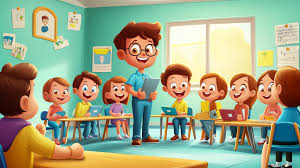The modern educational landscape has witnessed a remarkable evolution in teaching methodologies, with teachers increasingly recognizing the pedagogical value of multimedia resources. Among these valuable tools, kids animated shows stand out as particularly effective bridges between entertainment and education, offering engaging narratives that capture young imaginations while simultaneously delivering important educational concepts in accessible formats.
Forward-thinking teachers have discovered that strategic incorporation of quality kids animated shows can transform traditional learning environments into dynamic spaces where children eagerly absorb new information. The colorful characters, compelling storylines, and simplified explanations of complex topics make these programs invaluable supplements to conventional teaching methods, particularly for visual and auditory learners who might struggle with text-based instruction.
Educational research consistently demonstrates that information presented through multiple sensory channels enhances retention and comprehension. When students encounter concepts both through teacher instruction and animated reinforcement, they develop stronger neural pathways to that knowledge, making it more accessible for future application. This dual-channel approach proves especially beneficial for abstract concepts that young learners might find challenging to visualize based solely on verbal descriptions.
The careful selection of animated content requires pedagogical expertise. Experienced educators evaluate programs not merely for entertainment value but for educational merit, age-appropriateness, accuracy of information, and alignment with curriculum standards. This critical assessment ensures that classroom viewing time contributes meaningfully to learning objectives rather than serving merely as a passive activity.
Many contemporary animated shows incorporate deliberate scaffolding of concepts, introducing foundational ideas before building toward more complex applications. This structured approach mirrors effective teaching practices, allowing educators to use these programs as extensions of their instructional strategies. The repetition of key concepts through catchy songs, memorable characters, and visual demonstrations reinforces classroom lessons in ways that resonate with young learners.
Social-emotional learning represents another area where quality animated programming complements teacher-led instruction. Characters navigating friendship challenges, managing emotions, and demonstrating resilience provide concrete examples of abstract social skills. Teachers can reference these familiar scenarios when helping students work through real-life interpersonal situations, creating a common vocabulary and frame of reference.
Differentiated instruction becomes more manageable when animated resources are available. Students requiring additional explanation or alternative approaches to concepts can benefit from carefully selected animated content that addresses their specific learning needs. Meanwhile, those ready for enrichment can explore more advanced animated explanations that extend their understanding beyond grade-level expectations.
Language development thrives with exposure to the rich vocabulary and clear articulation typically featured in educational animations. For English language learners in particular, the combination of visual context clues and clearly spoken dialogue offers valuable language acquisition opportunities. Teachers who recognize this potential can select programs that incorporate target vocabulary or language structures aligned with current instructional goals.
Critical media literacy represents an essential twenty-first century skill that teachers can develop through guided engagement with animated content. By discussing how stories are constructed, analyzing character motivations, and identifying messages embedded within programming, educators transform passive viewing into active critical thinking exercises that prepare students for thoughtful media consumption throughout their lives.
The documentation of learning through creative response activities extends the educational value of animated programming beyond the viewing experience. Students might create alternative endings, design new characters that could join the show, or solve problems similar to those encountered by their favorite animated characters. These extensions transform entertainment into deeper learning opportunities.
Parent-teacher partnerships strengthen when quality animated resources are shared across home and school environments. When educators recommend specific programs that reinforce classroom learning, they provide families with tools to continue educational conversations beyond school hours. This continuity between learning environments maximizes the impact of both teacher instruction and animated content.
Digital citizenship naturally integrates with discussions around animated programming, as teachers help students understand concepts like creator attribution, appropriate viewing choices, and balanced screen time. These conversations lay groundwork for responsible technology use that will serve students throughout their academic careers and beyond.
As educational technology continues evolving, the relationship between traditional teaching and animated resources grows increasingly symbiotic. Augmented reality experiences, interactive episodes, and customizable animated learning modules represent the next frontier in this educational partnership. Teachers who stay informed about these developments position their students to benefit from cutting-edge resources that make learning both effective and enjoyable.

